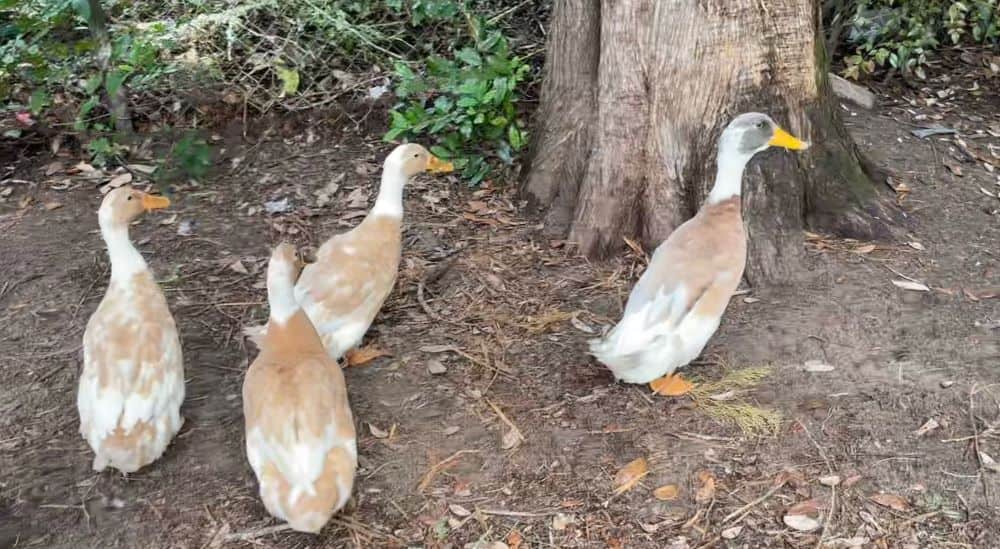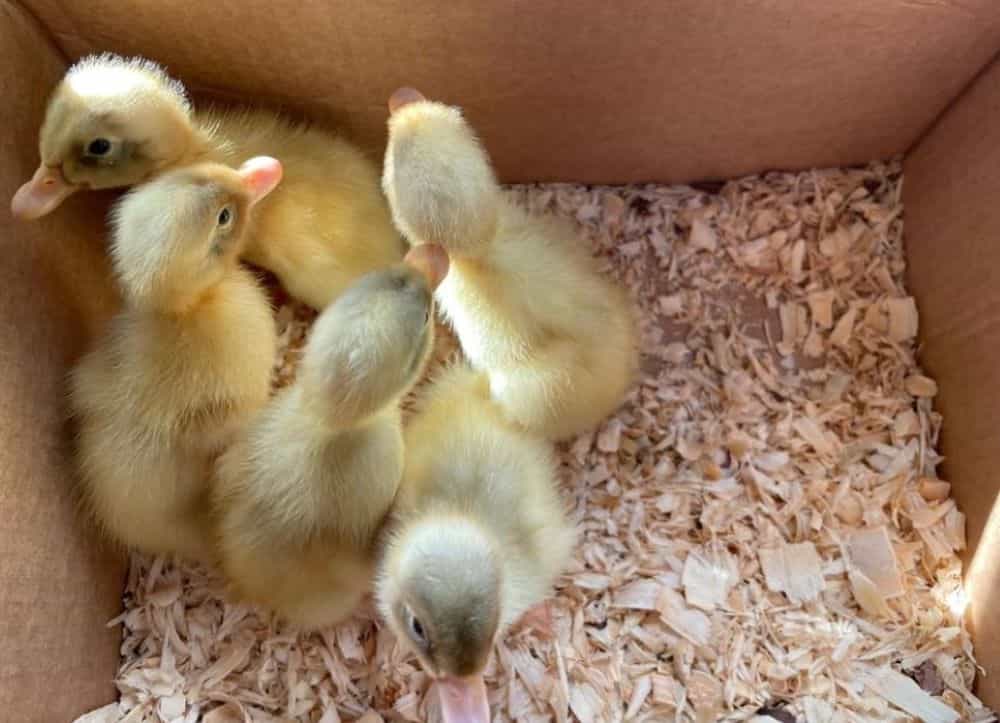Owning Indian runner ducks is an entertaining enterprise, and they are one of the best backyard poultry breeds for egg production in the world. Indian runners have a unique and adorable look (imagine combining a penguin with a bowling pin), have a friendly disposition, and produce very large, high-quality eggs.
Indian runners will lay between 300 and 350 eggs per year. These eggs are noticeably large and generally green, blue, or white, depending on breed and diet. Better yet, these are very low-maintenance ducks that aren’t bothered in the slightest when you come outside to hang out and pet them.
If you happen to have a decent property size, they are highly independent and will forage on their own. These non-broody, child-friendly, beginner-friendly ducks are more than worth a look if you’re digging into the backyard poultry lifestyle. Like all pets, however, there is a right way and a wrong way to raise them, and this guide will walk you through the most important aspects of caring for these friendly birds.
Overview

Indian runner hens typically stick close to the drake, if you have a drake in your flock. If not, they will have an established leader.
©A-Z-Animals.com/Thomas Godwin
Indian runners are probably the most unique ducks, in terms of appearance, that you’re likely to find. They stand completely upright, like a penguin, and walk in straight rows with other Indian Runners. The drake will reach 4 to 5 lbs and 26″ to 32″ in height. The hen will reach 3 to 4 lbs and 24″ to 29″ in height.
Their wings are small, though they won’t hesitate to flap them vigorously as if they’re about to take off. They have zero up-and-down game so you don’t have to worry about clipping their wings to keep them from jumping your fence. Their long, sleek, and narrow bodies help them squeeze into areas you don’t want them to enter, however.
They rival the best foraging chickens and will seek out earthworms and all manner of bugs on their own, reducing feed costs throughout the year. Though they love water and will leap into any standing pool with extreme enthusiasm, they get along just fine without it.
Appleyard ducks often steal the limelight when it comes to backyard poultry choices. However, Indian runners easily match Appleyards as meat and egg ducks that (unlike the Appleyard) can’t just fly off.
Owning Indian Runner Ducks: From Egg To Juvenile

Indian Runner duck eggs are larger than typical large and medium chicken eggs. From left to right, Olive Egger,
Rhode Island Red
, Indian Runner, Indian Runner (2), and Gold-Laced Wyandotte.
©A-Z-Animals.com/Thomas Godwin
Despite the understanding that Indian runners are low-maintenance ducks, there is still a large degree of responsibility you have to take on if you want a flock of them in your backyard. Low-maintenance and ignored are not one and the same.
Hatchlings

©A-Z-Animals.com/Thomas Godwin
Owning Indian runner ducks begins with hatchlings. As with chickens, feed and seed stores sell “chick-starter” crumbles. This is where the real responsibility begins, because crumbles are sufficient but not enough to encompass the entirety of an Indian runner duckling’s diet.
These crumbles generally have enough protein, but they tend to be low on a very important ingredient in a runner’s diet—niacin. Niacin is almost as significant as protein because it’s the primary nutrient ducks need to break down proteins, fats, and carbs. Chickens only need about half the niacin amount that ducks need. If you’re introducing runners to a chicken flock, you have to carefully monitor and sometimes separate their food.
With only chick crumble, Indian runners might develop bowed and twisted legs, have seizures, fail to gain any weight, and potentially die. The good news is, there are plenty of healthy alternatives to introduce at a very young age, directly in their feed. One of these alternatives is sweet peas. Cans of sweet peas are loaded with niacin and ducklings are more than capable of swallowing the peas down.
Meal worms, tuna fish, legumes, bananas, cooked brown rice, some cereals, and legumes are all excellent foods that are duck-friendly and loaded with niacin. Without these additives, carefully select your duck starter feed and ensure that it’s high in niacin content—twice that of chicken starter.
Diet and Growth
Owning Indian runner ducks is not hard, but it’s the lack of knowledge that sees first-timers fail so often. As your ducklings grow, they need an environment with a heat source. A small pool with a pine shaving bedding, hay, or straw is sufficient. As far as the heating is concerned, it changes as the ducks grow.
| Duckling Age | Temperature Recommendation |
|---|---|
| Up to 1 week | 90 °F |
| 1 to 2 weeks | 90 °F |
| 2 to 3 weeks | 85 °F |
| 3 to 4 weeks | 80 °F |
| 4 to 5 weeks | 75 °F |
Every 2 to 3 days, be sure to change their entire bedding out and replace it. This is the perfect time to handle them and get them used to you if you haven’t done so already. Feed them while they are in your hands and gently place them back when you are done. Fresh water is a daily must, and you can even throw a bowl of water in there for them to play with, though they will make a bit of a mess.
Ducks, unlike chickens, use water to swallow their food, so they need plenty of it. As you watch them eat, you will notice they run to their water every few seconds and take a gulp. Once the Indian runners are between 6 and 8 weeks of age, you’ll notice their feathers growing in. Now, it’s time to introduce them to their duck coop.
Duck Coop
Of course, there’s no owning Indian runner ducks without a duck coop. They’ll need a place to stay, lay eggs, retreat from potential predation, and sleep (if they take to their coop well enough). Indian runners like to sleep out in the open, so they may not sleep inside their coop every night.
When you first bring them outside, make it a gradual thing, for a few hours each day, expanding their time in the coop as you go. Make sure that any chickens or other ducks you own are blocked off from the coop. The ducklings are still too young to properly defend themselves throughout the establishment of a pecking order.
Duck coops, unlike chicken coops, don’t require elevation, though it’s fine if you want to use a chicken coop or modify an existing one. Just be sure the ducks have an easy way in and out. They have claws, but Indian runners can’t perch or grasp to climb. Inside or out, their bedding needs cleaning regularly, and a bay or two for laying.
They’re fine to share in the chicken feed. However, you still need to supplement their diet with elevated niacin levels. If you have chickens, feed your Indian runners at night. They don’t mind the night life, and the chickens will remain in their coops. Straw and sawdust bedding is best for juvenile and adult ducks, though pine shavings will do in a pinch. Make sure the coop is breathable, and 4 × 6 feet in size per duck.
Owning Indian Runner Ducks: Juvenile to Adult

Drakes are a little taller than the hens, with a darker head that’s green, gray, or several shades of either.
©A-Z-Animals.com/Thomas Godwin
Things get a little easier here. The main thing you want to be sure of is that they are adequately provided for outside and are restrained from moving very far before getting acquainted with their new surroundings.
Feeding and Free-Ranging
One of the biggest boons to owning Indian runner ducks is that you don’t have to dump a ton of feed on them to keep them happy. Many people, who have very small yards, are inevitably disappointed in expense versus return with backyard poultry. Feed, coops, and maintenance ultimately cost the same or more than just going to the store and buying a carton of eggs.
Of course, you miss out on the fun of having a huge flock of chickens and ducks that follow you everywhere you go! Indian runners are fantastic foragers, hunting down grubs, flies, blackberries, caterpillars, worms, leaves, and insects they can get a hold of.
If you do provide feed, be sure to keep the protein content in the 15% to 20% range. You don’t have to go out of your way to find a feed with higher niacin once the ducks reach the adult stage. But, you should occasionally go outside and give them some peas or a can of tuna. They’ll absolutely love it, and you even more for bringing it.
Again, if you’re raising chickens at the same time, any medicated feed used for your chickens is not good for your ducks. Be sure to separate medicated chicken feed if you ever have to use it.
Drakes Versus Hens
Indian runners are a lot like chickens when your choices boil down to including or excluding a drake with your hens. The only difference is that the Indian runner drake is very quiet, while the hens are very loud. The drake is more colorful, usually with a head color that differs drastically from the rest of its body.
Drakes do their best to be the voice of the flock, but all they are capable of is a repetitive, raspy sound that fails to carry very far. The hens, on the other hand, are the Donald Ducks of the show, with their loud, distinctive quacks. When hens are excited, they will easily rival a human shout in decibels, if not more.
The hens are clearly smaller than the drakes, but It’s difficult to sex them as ducklings. They will generally follow the drake wherever it goes, often in a straight-file line, chest to back, walking in concert and quacking away. The best ratio of hens to drakes is three to one. An additional drake may cause anxiety and stress if the drakes decide to go at each other.
Also, if you introduce a drake when your hens are fully grown, there’s an adjustment period as they suffer through the surprise of a mating-ready male. If you decide to go with more numerous Indian runners, maintain the 3:1 ratio and understand that scuffles will invariably ensue.
Egg Laying And Production
The most exciting aspect of owning Indian runner ducks is finding the first egg. On average, the hens will lay 5 eggs per week, possibly more. Their eggs are large and green, blue, or white. To give you an idea of the size, expect the eggs to be slightly larger than Grade A Jumbo eggs from the supermarket.
Unlike chicken eggs, Indian runner eggs are much stronger, harder to crack, and richer in taste, regardless of how you cook them. Even if you have a drake, as long as you pick up the eggs daily and place them in the fridge, the eggs won’t have time to develop a little duckling within.
For the most part, the hens will lay eggs inside their laying bins in the coop. However, don’t be surprised if once in a blue moon, they decide to create a secret stash somewhere in your yard. Indian runner mothers are hardly motherly. They are rarely broody, which means they won’t lay on their eggs to provide them with warmth. If you want to breed and hatch Indian runners, you need an incubator.
Don’t depend on mother Indian runners to look after their ducklings either. From the moment they hatch, the odds are good that it’ll be all on you to take care of them.
Owning Indian Runner Ducks: Long-Term

Drakes will vigorously defend their hens, even from a friendly but curious, full-grown Doberman.
©A-Z-Animals.com/Thomas Godwin
After a month or two of owning Indian runner ducks, you’ll be far too attached to make this a short-term venture. They are highly sociable, especially if you spend a good deal of time with them while they grow. Associating you with duck treats and feeding time also helps a lot. There are a few things you should know as far as long-term care.
Noise Levels
You don’t have to worry about the drakes, but the hens will blow your windows out or, at least it seems like that. Fortunately, they don’t vocalize constantly, but they will start quacking any time they get excited or are mating with the drake.
If they are used to you feeding them, they will quack at your every approach. The good news is, quacking at you means quacking at all humans, assuming everyone who comes in the yard is there to feed them. This makes for some pretty good home security. The only problem is, being in a neighborhood may aggravate your neighbors. Keep this in mind if your yard is close to other houses.
Legal Issues
If you live in a rural area, chances are good that owning Indian runner ducks is fine. Living in the suburbs or within city limits is different, depending where you are located. Check with your local authorities to make sure that owning Indian runner ducks is legal. For the most part, you will probably have to pay between $25 and $100 for a license to own them.
Though some places regulate chickens, ducks are waterfowl, which places them in a separate category. Just because it’s okay to own chickens, doesn’t mean you’re automatically in the clear to own ducks.
Mixing Indian Runners And Chickens
This is normally not much of a deal. However, the drake is your biggest concern. Chickens and Indian runners are neutral towards each other. But the drake will sometimes try to mate with a chicken hen, which is potentially deadly for her. A female chicken is not designed for penetration. On top of that, male duck drakes have corkscrew penises, and they will seriously injure a chicken hen while attempting to mate.
It doesn’t help that Indian runner drakes are brutally aggressive when mating. If you have a drake in your flock, its best to keep them separate from the chickens if it’s trying to mate with them.
Health Issues
The most common health issue with Indian Runner ducks is worms and mites. Routinely deworm your flock once or twice a year. You can purchase deworming medication at your local feed and seed. Mites are simpler. All you have to do is provide your ducks with a clean coop. Sprinkle some diatomaceous earth on their fresh bedding as well. If mites appear, clean the entire coop, top to bottom, and treat the coop and ducks with Carbaryl.
Final Thoughts
That just about covers owning Indian runner ducks and raising them. They’re honestly a lot of fun and the egg production is bar none. With just a small flock of three or four hens, you will have more eggs than you can handle before you know it. Combined with chicken eggs, duck eggs are a nice change-up.
Though Indian runners are prolific egg layers, their greatest value is in their sociability and companionship. They make excellent, friendly backyard pets and they’ll happily clear out your insect problems in short order. If you’re in the market for a happy, egg-laying, friendly backyard bird, with a distinctively interesting look, put Indian runners on your list.
The photo featured at the top of this post is © A-Z-Animals.com/Thomas Godwin
Thank you for reading! Have some feedback for us? Contact the AZ Animals editorial team.






